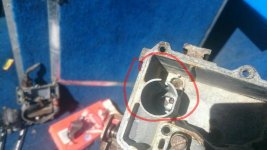FstaRockr Burns
Regular Contributor
Hi all.. So pulled carburetor on motor, it's 2 barrel rochester.. I can't seem to locate the passage under the accelerator plunger, on quadrajets theres usually a small ball bearing that blocks fuel flow back into float chamber..
Mine just looks blocked. The small recess outside plunger housing also seems undrilled. I would assume this is a safety feature or am I missing something?
Surely the plunger needs to draw fuel in before squirting it up into carb?
The outgoing passage is there but for the life of me cannot find the supplying hole...
??

Mine just looks blocked. The small recess outside plunger housing also seems undrilled. I would assume this is a safety feature or am I missing something?
Surely the plunger needs to draw fuel in before squirting it up into carb?
The outgoing passage is there but for the life of me cannot find the supplying hole...
??


